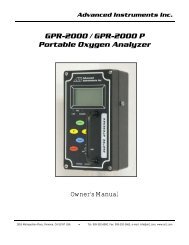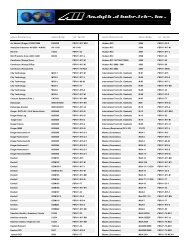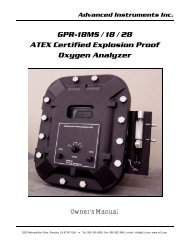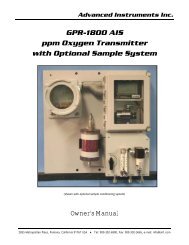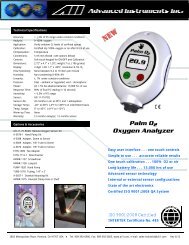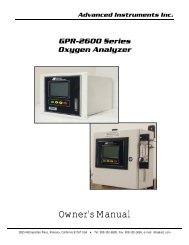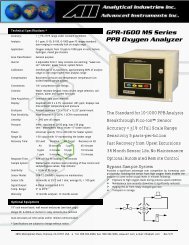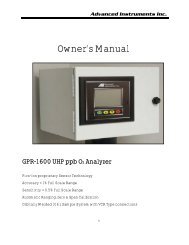GPR-1200 Portable ppm Oxygen Analyzer - Advanced Instruments Inc.
GPR-1200 Portable ppm Oxygen Analyzer - Advanced Instruments Inc.
GPR-1200 Portable ppm Oxygen Analyzer - Advanced Instruments Inc.
Create successful ePaper yourself
Turn your PDF publications into a flip-book with our unique Google optimized e-Paper software.
and, the NPT end is taped and securely tightened into the mating male quick disconnect fittings which mate with thefemale fittings on the analyzer5. Assure there are no restrictions in the sample gas lines – inlet or vent.6. For sample gases under positive pressure the user must provide a means of regulating the inlet pressure between 5-30psig, the analyzer is equipped with a FLOW VALVE to set the flow rate at the recommended 2 SCHF.7. For sample gases under atmospheric or slightly negative pressure an optional sampling pump is recommended to draw thesample into the analyzer. Generally, no pressure regulation or flow control device is involved. Caution: If the analyzer isequipped with both a FLOW VALVE upstream of the sensor and an integral SAMPLING PUMP downstream of the sensor,always open the FLOW VALVE completely before operating the pump (avoid drawing a vacuum on the sensor).8. Assure the sample is adequately vented for optimum response and recovery – and safety.To avoid erroneous oxygen readings and damaging the sensor:‣ Do not place your finger over the vent (it pressurizes the sensor) to test the flow indicator when gas is flowing to thesensor. Removing your finger (the restriction) generates a vacuum on the sensor and may damage the sensor (voiding thesensor warranty).‣ If the analyzer is equipped with an optional integral sampling pump (positioned downstream of the sensor), completelyopen the flow control metering valve (positioned upstream of the sensor) to avoid drawing a vacuum on the sensor andplacing an undue burden on the pump.‣ Assure there are no restrictions in the sample or vent lines‣ Avoid drawing a vacuum that exceeds 14” of water column pressure – unless done gradually‣ Avoid excessive flow rates above 5 SCFH which generate backpressure on the sensor.‣ Avoid sudden releases of backpressure that can severely damage the sensor.‣ Avoid the collection of particulates, liquids or condensation collect on the sensor that could block the diffusion of oxygeninto the sensor.StandbyThe analyzer has no special storage requirements.1. The sensor should remain connected during storage periods.2. Store the analyzer with the power OFF.3. If storing for an extended period of time, charge before operating.6 MaintenanceWith exception of components related to optional equipment and charging the battery of portable analyzers, cleaning theelectrical contacts when replacing the sensor is the extent of the maintenance requirements of this analyzer as there are noserviceable parts in the analyzer given the nature of the solid state electronics and sensor.Serviceability: Except for replacing the oxygen sensor, there are no parts inside the analyzer for the operator to service. Onlytrained personnel with the authorization of their supervisor should conduct maintenance.Sensor ReplacementPeriodically, the oxygen sensor will require replacement. The operating life is determined by a number of factors that areinfluenced by the user and therefore difficult to predict. The Features & Specifications define the normal operating conditionsand expected life of the standard sensor utilized by the <strong>GPR</strong>-<strong>1200</strong> Series analyzer. Expected sensor life is inversely proportionalto changes in oxygen concentration, pressure and temperature.26



